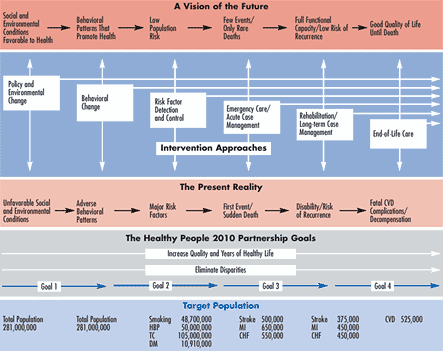 |
|
 |
 |
 |
A
Public Health Action Plan to Prevent Heart Disease and Stroke
Return to Table of Contents
The
Public Health Response
|
The Steps to a HealthierUS initiative envisions a healthy, strong
United States where diseases are prevented when possible, controlled
when necessary, and treated when appropriate. This initiative is a
bold shift in our approach to the health of our citizens, moving us
from a disease care system to a health care system. We can no longer
sustain the skyrocketing health care costs created by an over
reliance on treatment, nor should Americans continue to suffer from
preventable diseases. |
Substantial public health achievements have
been made in preventing heart disease and stroke, but they are insufficient
to arrest or reverse the epidemic. Public health serves society by
guaranteeing conditions of life in which people can be healthy and by
addressing three core functions—assessment, policy development, and
assurance.13 Achievements in these areas as they relate to heart
disease and stroke6 include the following:
- Assessment. For several decades, public health agencies and
researchers have collected data on the epidemic and conducted research on
how to control it. Although important gaps persist, the accumulated
knowledge provides a solid evidence base for public health decision
making.
- Policy development. A wealth of policies has been developed on
the basis of this knowledge. Some policies have been implemented
effectively but await broader, more intensive application to achieve their
full impact. Others have yet to be acted upon. Evaluating these policies
requires implementation on a sufficient scale and adequate resources for
evaluation.
- Assurance. Assurance, measured by how much society is protected
from epidemic heart disease and stroke, remains to be achieved despite
recent progress. Public health agencies can put current knowledge to work
through a targeted plan of action. Unfortunately, most public health
agencies are not yet well–equipped for this task.13
The U.S. Department of Health and
Human Services (HHS) and its component agencies, including NIH and
especially its National Heart, Lung, and Blood Institute and National
Institute of Neurological Disorders and Stroke, represent a long history of
research and program development in the area of heart disease and stroke for
both health professionals and the public. It is beyond the scope of this
document to inventory the contributions of even one agency, much less those
of HHS as a whole, but it is important to recognize that today's knowledge
base about prevention of heart disease and stroke is, to a large degree, a
reflection of this work. Other organizations, especially the American Heart
Association, also have supported research that has led to the kinds of
policy developments—often in partnership with others, such as the American
College of Cardiology—that underlie the present opportunity for heart
disease and stroke prevention. CDC has contributed in this area for many
years through its laboratory standardization, surveillance, and vital
statistics activities, as well as through more recent public health program
implementation.

Note: Healthy People 2010 goals are explained
in the text. HBP = high blood pressure, TC = total cholesterol, DM =
diabetes mellitus, MI = myocardial infarction, CHF = congestive heart
failure, CVD = cardiovascular disease.
Figure 1. Action Framework for a Comprehensive Public
Health Strategy to Prevent Heart Disease and Stroke
[view
larger image]
In the context of this HHS tradition, Secretary Thompson's Steps to a
HealthierUS initiative is a significant new development. It calls for
marshalling all available resources within HHS and for action by other
federal agencies, such as transportation, agriculture, and education, and
private–sector interests, such as the food industry and many others. All are
urged to take steps to improve the nation's health. Further, this initiative
calls on policy makers to embrace prevention as the first step toward
solving our nation's health care crisis. Clearly, it is understood that
business as usual will not be sufficient to meet today's challenges in
addressing chronic diseases and conditions, including heart disease and
stroke.
Next Section: The Action
Plan
Return to
Table of Contents
Date last reviewed:
05/12/2006
Content source: Division for Heart Disease and Stroke
Prevention,
National Center for Chronic Disease Prevention and
Health Promotion |
|